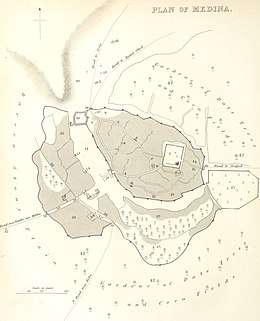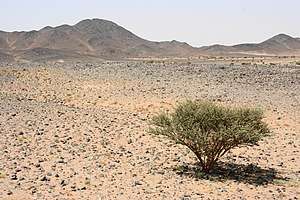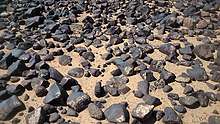Battle of al-Harra
The Battle of al-Harra (Arabic: يوم الحرة, romanized: Yawm al-Ḥarra lit. 'the day of al-Harra') was fought between the Syrian army of the Umayyad caliph Yazid I (r. 680–683) led by Muslim ibn Uqba and the local defenders of Medina, namely the Ansar and Muhajirun factions, who had rebelled against the caliph. The battle took place at the lava field of Harrat Waqim in the northeastern outskirts of Medina on 26 August 683.
The elite factions of Medina disapproved of the hereditary succession of Yazid, unprecedented in Islamic history until that point, resented the caliph's impious lifestyle, and chafed under Umayyad economic policies. After declaring their rebellion, they besieged the Umayyad clan resident in Medina and dug a defensive trench around the city. The expeditionary force sent by Yazid together with the local Umayyads, who had since been released from the siege, encamped at Harrat Waqim where they were confronted by the rebels. Despite an initial advantage, the Medinese were routed as a result of the defection of one of their factions, which enabled Umayyad horsemen led by Marwan ibn al-Hakam to attack them from the rear.
Afterward, the army pillaged Medina for three days, though accounts of the plunder vary considerably. The Syrian army proceeded to besiege the rebel leader Abd Allah ibn al-Zubayr in Mecca, though Ibn Uqba, who was maligned in Muslim traditional sources for his role in Medina's plunder, died en route. The Battle of al-Harra is described as one of the Umayyads' "major" crimes by the traditional sources.[1]
Location
The location of the battle was in a lava field known as Harrat Waqim, which straddles the eastern outskirts of Medina in the Hejaz (western Arabia).[2][3] It was named after the Waqim fortress of the Banu Qurayza tribe that had been resident in the area during the pre-Islamic period and was alternatively known as Harrat Bani Qurayza or Harrat Zuhra.[4] It formed part of the vast geological system of ḥarras (basaltic deserts) which spanned the region east of the Hauran in Syria southward to Medina's environs.[5] As a result of the fame of the battle, Harrat Waqim was thenceforth referred to in Muslim sources as "the Harra".[3]
Background
The hereditary succession of the Umayyad caliph Mu'awiya I's son Yazid I in 680 had been unprecedented act in Islamic history and was a point of contention among the people of Medina, particularly the eminent Muslim leaders of the Hejaz.[6] One of them, Husayn, a son of Caliph Ali (r. 656–661) and grandson of the Islamic prophet Muhammad, left Medina to lead a revolt against Yazid in Iraq, but was slain alongside his entire band of about seventy followers at the Battle of Karbala by the forces of the Umayyad governor Ubayd Allah ibn Ziyad; Yazid had the head of Husayn put on display in Damascus.[7] Reports of impious behavior by Yazid, including entertainment by singing girls and a pet monkey contributed to prevailing attitudes in Medina of his unsuitability as caliph.[8] The Medinese consisted of the Ansar (native Medinese who had hosted and allied with Muhammad after his emigration from Mecca in 622) and the Muhajirun (Muhammad's early supporters who had emigrated with him). The Muhajirun were dominated by the Quraysh, the tribe to which Muhammad, Ali and the Umayyads belonged.[9] At the time of the opposition to Yazid, the Medinese were mostly the children of the two factions, i.e. Islam's first military generation, and felt threatened at the potential loss of the inherited military pensions brought about by Umayyad fiscal reforms; the reforms called for pensions to be given only in exchange for direct military service.[3]
To reconcile with the Medinese, Yazid requested that they send a delegation to his court in Damascus.[3] The governor of Medina, Yazid's cousin Uthman ibn Muhammad ibn Abi Sufyan, organized the Medinese embassy to Damascus.[10] Yazid attempted to win over the delegates by lavishing them with gifts and money.[3][10] This proved fruitless when the delegates returned and incited the people of Medina with accounts detailing Yazid's scandalous lifestyle.[3] The most vociferous critic among the delegates was Abd Allah ibn Hanzala. He declared that he and his sons would fight against Yazid should others not help him and though he was respected by Yazid, he would use the gifts the latter gave him against the caliph.[11] Meanwhile, Abd Allah ibn al-Zubayr, a grandson of the first caliph Abu Bakr (r. 632–634), had taken control of Mecca in September 683, established his headquarters in the Ka'aba and allied with Ibn Hanzala in opposition to Yazid.[8][12][13]
Prelude
Uthman ibn Muhammad ibn Abi Sufyan was unable to control the growing opposition to Umayyad rule.[3] According to the early Muslim historian al-Mada'ini (d. 843), the inaugurating act of rebellion by the Medinese occurred during a gathering in the mosque where the attendees each tossed an article of clothing, such as a turban or a shoe, an Arab custom symbolizing a severing of ties, to renounce their allegiance to Yazid.[14] According to another early Muslim historian Abu Mikhnaf (d. 774), the first act of rebellion by the Medinese was giving allegiance to Ibn Hanzala.[15] Afterward, they assaulted the Umayyads and their supporters in the city, together about 1,000-strong, who fled to the quarter of their senior elder, Marwan ibn al-Hakam.[16]
Marwan sent urgent requests for assistance from Yazid, who dispatched a 4,000 to 12,000-strong, well-equipped army of Syrian Arab tribesmen, dominated by the Banu Kalb.[16][17] The expeditionary force was sent to suppress the opposition from both the Medinese and Ibn al-Zubayr.[8] As an incentive to the troops, who anticipated an arduous campaign ahead, each soldier was paid 100 dirhams over their regular stipend.[17] Yazid's initial choice for the commander of this force, the Umayyad Amr ibn Sa'id ibn al-As, refused the position out of a principle not to shed the blood of his fellow Quraysh, while Ubayd Allah, still reeling from the fallout from his role in the death of Husayn, also refused.[17] Instead, the loyal, elderly, non-Qurayshi veteran Muslim ibn Uqba was given the command.[16][17] According to the historian al-Ya'qubi (d. 897), Ibn Uqba's forces were composed of equal numbers of troops from the five junds (armies) of Syria: Rawh ibn Zinba al-Judhami led the men of Palestine, Hubaysh ibn Dulja al-Qayni led the men of Jordan, Abd Allah ibn Mas'ada al-Fazari led the men of Damascus, Husayn ibn Numayr al-Sakuni led the men of Homs and Zufar ibn al-Harith al-Kilabi led the men of Qinnasrin.[18]
Upon hearing of the Syrian advance, the Medinese reinforced the siege against the Umayyads of Medina, before allowing them to leave after they gave oaths not to assist the incoming army.[17] On their way to Syria, the exiled Umayyads encountered Ibn Uqba's army in the Wadi al-Qura region between Syria and Medina.[19] Ibn Uqba's inquiries about Medina's defenses were rebuffed by most of the Umayyads,[19] some of whom continued on their way north,[17] but Marwan's son Abd al-Malik cooperated and offered valuable intelligence.[19] Under Marwan's leadership, most of the exiles joined the expedition.[17] In Medina, the defenders, numbering about 2,000 men,[20] dug a trench to protect a vulnerable northern corner of the city and divided themselves into four units, two of which were commanded by members of the Quraysh, one by a member of the Banu Ashja and the other by Ibn Hanzala of the Ansar.[19] For three days starting on 23 August Ibn Uqba attempted negotiations with the Medinese leaders. He appealed for unity and promised two annual payments to the Medinese from Yazid and a significant price reduction of corn.[17] According to the historian Laura Veccia Vaglieri, this indicates that economic concerns contributed to the Medinese opposition of the Umayyads.[17]
Battle

The negotiations between Ibn Uqba and the Medinese faltered, and clashes ensued.[17] The Medinese horsemen marched against Ibn Uqba in the Harra,[19] and may have advanced as far as Ibn Uqba's litter,[21] from which he commanded his troops.[17] Upon their approach, Ibn Uqba confronted them on horseback and actively participated in the fighting.[17] The Medinese gained an early advantage,[17] but were ultimately overtaken by the Syrians and several Ansari and Qurayshi notables were slain, including Ibn Hanzala, eight of his sons and a handful of other men from the Medinese elite.[21] The medieval Arab historians Wahb ibn Jarir (d. 822) and al-Samhudi (d. 1533) held that Medinese lines were compromised by the defection of the Banu Haritha, who gave Marwan and his horsemen access through their quarter in Medina, enabling them to assault the Medinese at al-Harra from the rear.[21] The Quraysh, led by Abd Allah ibn Muti al-Adawi, fled the battlefield and headed for safety to Ibn al-Zubayr in Mecca.[17] According to the early Muslim source al-Waqidi (d. 747), the battle concluded on 26 August 683.[21]
Aftermath
Conflicting accounts abound regarding the aftermath of the Syrian victory. According to Abu Mikhnaf and al-Samhudi, Ibn Uqba gave his troops free rein to pillage Medina for three days.[21] The number of Medinese casualties incurred during the battle and immediate aftermath range from 180 to 700 members of the Ansar and Quraysh, and 4,000 to 10,000 other Medinese.[17] Al-Samhudi further claimed that as a result of the alleged rape of Medinese women by Ibn Uqba's troops, 1,000 illegitimate children were later born by them as a result.[22] The account of early Arab historian Awana ibn al-Hakam (d. 764) describes a more orderly capture, in which Ibn Uqba summoned the notables of Medina to give allegiance to Yazid at the Quba Mosque and used the occasion to execute several prominent leaders of the opposition movement, including a number from the Quraysh and Ma'qil ibn Sinan al-Ashja'i.[21] The latter had been a close friend and belonged to the same Ghatafan tribal grouping as Ibn Uqba, but was nonetheless executed for his disavowal of Yazid.[23] A son of Caliph Uthman (r. 644–656), a member of the Umayyad clan, had his beard cut as punishment for suspected collusion with the Medinese, though Ali ibn al-Husayn, a grandson of Caliph Ali, was well-treated on the personal instructions of Yazid.[17] Wahb ibn Jarir likewise did not make note of a three-day plunder of Medina and Wellhausen doubts that it occurred.[24] The accounts of Abu Mikhnaf and Awana agree that following the ordering of affairs in Medina, Ibn Uqba left to subdue Ibn al-Zubayr in Mecca, but fell ill and died on the way in al-Mushallal.[22] As ordered by Yazid, he left as second-in-command Husayn ibn Numayr al-Sakuni, who proceeded to besiege Mecca in September.[22]
The alleged cruelty against the townspeople of Medina by the Umayyad army became a cause célèbre that was invoked by future generations.[25] Ibn Uqba was thenceforth known as "Musrif", a play on his name "Muslim" that meant "he who exceeds all bounds of propriety".[25] The historian Michael Lecker considers the reports of Syrian atrocities in Medina as "undeniably anti-Umayyad and probably exaggerated".[26] Moreover, Wellhausen dismisses the depiction by later Muslim and western sources of Ibn Uqba as a brutal heathen with a deep hatred for Islam, in general, and the people of Medina, in particular, as a falsity that developed over time and is unsupported by the early and more credible Muslim sources.[27] In Wellhausen's assessment, the suppression of the Medinese revolt did not render a major decline to the city's political status; this had already been precipitated by the assassination of Caliph Uthman, the aftermath of which marked Medina's end as the capital of the nascent Muslim state.[9] The city continued to be a center for religious scholarship, Arab high culture and a redoubt for poets and singers.[9] Vaglieri counters Wellhausen's doubts about the extent of the army's pillage, asserting that the "[traditional Muslim] sources are unanimous on this point".[17]
References
- Hawting 2000, pp. 47-48.
- Smith 1994, p. 110, note 534.
- Vaglieri 1971, p. 226.
- Lecker 1985, p. 44.
- Editors 1971, p. 226.
- Wellhausen 1927, p. 141–142.
- Hawting 2000, p. 50.
- Hawting 2000, p. 47.
- Wellhausen 1927, p. 161.
- Wellhausen 1927, p. 152.
- Howard 1990, p. 219.
- Anthony 2016, p. 12.
- Gibb 1960, p. 55.
- Wellhausen 1927, p. 153.
- Wellhausen 1927, pp. 153–154.
- Wellhausen 1927, p. 154.
- Vaglieri 1971, p. 227.
- Biesterfeldt & Günther 2018, pp. 944–945.
- Wellhausen 1927, p. 155.
- Bewley 2000, p. 98.
- Wellhausen 1927, p. 156.
- Wellhausen 1927, p. 157.
- Wellhausen 1927, pp. 156–157.
- Wellhausen 1927, pp. 157, 159.
- Lassner 1986, p. 51-52.
- Lecker 2011, p. 179.
- Wellhausen 1927, pp. 159–160.
Sources
- Anthony, Sean W. (2016). "The Meccan Prison of ʿAbdallāh b. al-Zubayr and the Imprisonment of Muḥammad b. al-Ḥanafiyya". In Pomerantz, Maurice A.; Shahin, Aram A. (eds.). The Heritage of Arabo-Islamic Learning: Studies Presented to Wadad Kadi. Leiden and Boston: Brill. pp. 3–27. ISBN 978-90-04-30590-8.CS1 maint: ref=harv (link)
- Biesterfeldt, Hinrich; Günther, Sebastian (2018). The Works of Ibn Wāḍiḥ al-Yaʿqūbī (Volume 3): An English Translation. Leiden: Brill. ISBN 978-90-04-35621-4.CS1 maint: ref=harv (link)
- Bewley, Aisha (2000). The Men of Madina by Muhammad Ibn Sa'd, Volume 2. Ta-Ha Publishers. ISBN 9781897940907.CS1 maint: ref=harv (link)
- Editors (1971). "Ḥarra". In Lewis, B.; Ménage, V. L.; Pellat, Ch. & Schacht, J. (eds.). The Encyclopaedia of Islam, New Edition, Volume III: H–Iram. Leiden: E. J. Brill. p. 226. OCLC 495469525.CS1 maint: extra text: authors list (link)
- Gibb, H. A. R. (1960). "ʿAbd Allāh ibn al-Zubayr". In Gibb, H. A. R.; Kramers, J. H.; Lévi-Provençal, E.; Schacht, J.; Lewis, B. & Pellat, Ch. (eds.). The Encyclopaedia of Islam, New Edition, Volume I: A–B. Leiden: E. J. Brill. pp. 54–55. OCLC 495469456.
- Hawting, Gerald R. (2000). The First Dynasty of Islam: The Umayyad Caliphate AD 661–750 (Second ed.). London and New York: Routledge. ISBN 0-415-24072-7.
- Howard, I. K. A., ed. (1990). The History of al-Ṭabarī, Volume XIX: The Caliphate of Yazīd ibn Muʿāwiyah, A.D. 680–683/A.H. 60–64. SUNY Series in Near Eastern Studies. Albany, New York: State University of New York Press. ISBN 978-0-7914-0040-1.
- Lassner, Jacob (1986). Islamic Revolution and Historical Memory: An Inquiry Into the Art of ʻAbbāsid Apologetics. American Oriental Society.CS1 maint: ref=harv (link)
- Lecker, Michael (1985). "Muhammad at Medina — A Geographical Approach". Jerusalem Studies in Arabic and Islam. 6: 29–62.CS1 maint: ref=harv (link)
- Lecker, Michael (2011). "The Jewish Reaction to the Islamic Conquests". In Krech, Volkhard; Steinicke, Marion (eds.). Dynamics in the History of Religions Between Asia and Europe: Encounters, Notions, and Comparative Perspectives. Brill. ISBN 978-90-04-18500-5.CS1 maint: ref=harv (link)
- Smith, G. Rex, ed. (1994). The History of al-Ṭabarī, Volume XIV: The Conquest of Iran, A.D. 641–643/A.H. 21–23. SUNY Series in Near Eastern Studies. Albany, New York: State University of New York Press. ISBN 978-0-7914-1293-0.
- Vaglieri, L. Veccia (1971). "Al-Ḥarra". In Lewis, B.; Ménage, V. L.; Pellat, Ch. & Schacht, J. (eds.). The Encyclopaedia of Islam, New Edition, Volume III: H–Iram. Leiden: E. J. Brill. pp. 226–227. OCLC 495469525.
- Wellhausen, Julius (1927). The Arab Kingdom and its Fall. Translated by Margaret Graham Weir. Calcutta: University of Calcutta. OCLC 752790641.


